Advanced Arcana III
Preview
If you don’t already know that Advanced Arcana III came out earlier this week, then you should immediately go buy it, and forget about this article. It’s easily the best thing that’s happened to magic in a long time, and I think that it’s definitely our best Advanced Arcana yet (and the previous two were pretty awesome).
What’s that? You don’t want to just take my word for it? You want some kind of proof? Something to entice you to purchase the product? Well, I suppose that’s not unreasonable. But you’ll want to make sure you’re ready for the sheer amount of awesome I’m about to unveil. Don’t say I didn’t warn you.
You may remember that last week, I previewed two spells from Advanced Arcana III: cast in chains and Sorvithal’s blackest curse. The latter represents one of the four mechanical “themes” of AA3. For those of you who have sadly lived your lives without a copy of our previous Advanced Arcana books, each book explores a major theme, like “What is the cost of a spell?” or “How can we make spells feel different every time we cast them?” For Advanced Arcana III, that theme is “What if we made spells that didn’t act like spells?” and, honestly, I couldn’t be happier with the results.
Our good friend Sorvithal’s spell is an example of an ascension spell, which is a spell that has more than one spell-level, with discrete and different effects at each level. With a few exceptions, these spells allow you to get the effects of all the lower-level versions, which can create some spells that are not only quite potent, but also incredibly versatile. Advanced Arcana III has a nine-level spell for each school of magic (Sorvithal’s blackest curse being the necromancy one), as well as a handful of other ascension spells with 2-4 levels.
Another mechanic I’m especially proud of is metamagic spells, which are more or less exactly what they sound like: spells that alter other spells. Why don’t you take a look at this one:
Veltannia’s Dazing Touch
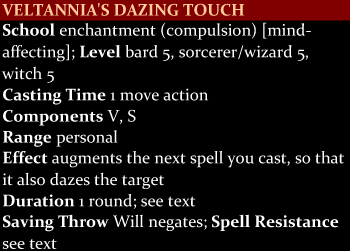
This spell creates a powerful energy of mental disruption which is magically grafted onto the next spell you cast, carrying its effects onto the target. The next spell you cast before the end of your turn is augmented in such a way that if it has a single target, that target is dazed for a number of rounds equal to the modified spell’s level.
If the modified spell requires an attack roll, then the attack must hit in order for Veltannia’s dazing touch to have any effect. If the modified spell allows the target a saving throw to resist some or all of its effects, then the target must fail that saving throw in order for Veltannia’s dazing touch to have any effect. The Will save to resist Veltannia’s dazing touch is separate from any other saving throw the modified spell might allow, and uses the DC appropriate for Veltannia’s dazing touch, not the modified spell. If the modified spell has a saving throw that is denoted as harmless, it is no longer considered harmless. Finally, if the modified spell is subject to spell resistance, the additional effect provided by Veltannia’s dazing touch is also subject to spell resistance (roll only once for the modified spell. If it is resisted, so is Veltannia’s dazing touch).
Pretty neat, huh? The third mechanic is a bit more “out-there,” and is known as an arcane well spell. Let me show it to you before I try to explain it.
Scorching Wrath
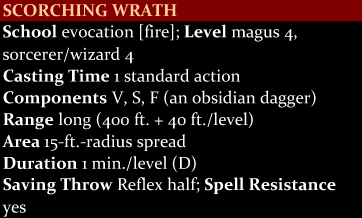
This spell functions as the spell fireball, except as noted here, and that creatures in the affected area take 1d6+1 points of fire damage per caster level, instead of the normal amount.
Arcane Well: As long as you have scorching wrath prepared, as a standard action, you can unleash a ray of fiery energy. Treat this as a ranged touch attack with a maximum range of 60 feet. On a successful hit, this deals 1d8 points of fire damage to the target. This is treated as a spell-like ability of the evocation school and the fire descriptor. Using this ability does not expend any spell slots. Once scorching wrath has been cast, and is no longer prepared, you cannot make use of this ability until the next time you rest and prepare scorching wrath.
Obviously the idea here is kind of similar to certain feats from a certain late-3.5-era book, but contained on the spell itself, instead of as a general feat. You usually don’t get as much bang out of the main spell effect as you would for a spell of that level, but you get access to the nifty “arcane well” ability for as long as the spell remains prepared, creating interesting tension about whether to use the spell, or save it to keep the arcane well ability.
I’m also quite fond of the next type of spell, which is known as an “opportune spell.” The idea here is that there is a special set of circumstances, or a specific trigger action, that allows the spell to be cast much more easily than normal. That is, instead of being a standard action to cast, the spell is only a swift, free, or immediate action (depending on exactly what the spell is intended to do and what its “trigger” is). Let me show you one in action.
Ardesalf’s Arcane Response
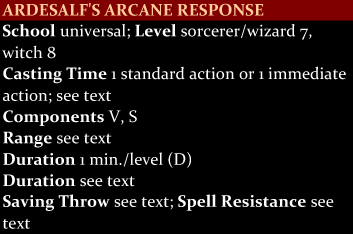
You tap raw magical energy to perfectly copy a spell that was just cast. When you cast this spell, it replicates the effects of a single spell that was cast in the last round. You must have witnessed the spell being cast, and also successfully identified the spell using Spellcraft. The spell in question cannot have been cast from a scroll, staff, wand, or any other item, nor can Ardesalf’s arcane response allow you to copy a spell-like ability. The spell being copied cannot have a casting time in excess of a standard action, and cannot require costly material components, or Ardesalf’s arcane response fails and has no effect.
You may cast the spell even if you would not ordinarily be able to (such as because the spell does not appear on your spell list, or it belongs to a prohibited school, or it is too high a level for you to cast), but you can only copy spells cast by others: you cannot copy a spell that you yourself cast. Ardesalf’s arcane response is an exact copy of the chosen spell, except that the spell is considered to have been cast by you (it still uses the original caster’s caster level, ability scores, saving throw DC, and so on.) and that you make any choices about the spell (such as the target, if applicable, and any other decisions the spell requires).
You may cast this spell as an immediate action, instead of a standard action, whenever you counter a spell. When cast in this way, the spell Ardesalf’s arcane response copies must be the countered spell.
Now, that may be all in the way of special spell mechanics, but don’t think that that’s all there is to Advanced Arcana III. Even forgetting about the appendices, which are filled to the brim with cool things like awesome new sorcerer bloodlines, a complete re-envisioning of witch patrons that will change the way you look at the class, and potions, scrolls, and wands like you’ve never seen before, there’s also dozens of cool “one-off” spells that don’t tie into special mechanics, but just focus on being extra awesome. Let me show you two of my favorites before we go, hmm?
Spell Purge
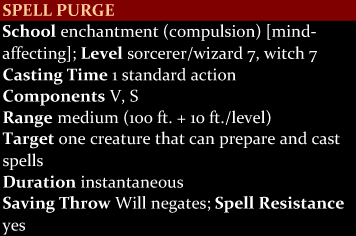
With this spell, you reach into the mind of your target and remove one or more prepared spells. If the target fails its Will save, you immediately become aware of what spells (if any) the target currently has prepared. You may choose any number of those spells, as long as the total sum of their spell levels does not exceed twice your caster level. The target immediately forgets those spells, as though they had just been cast (for example, a 13th-level wizard who cast this spell could cause his target to expend 26 spell levels’ worth of spells. He could choose two 9th-level spells and an 8th-level spell, or six 4th-level spells and a 2nd-level spell, or any other combination that added up to 26 spell levels or less. The chosen spells would be lost, without effect, and the target would not be able to cast them again until the next time he rested and prepared spells.). This spell has no effect on spontaneous spellcasters.
Flight of Black Wings
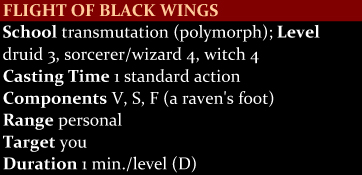
With a word, your form seems to simply dissolve into an inky blackness as dozens of ravens emerge from where you once stood. You are polymorphed into not one of these ravens, but all of them at once. Controlling so many unfamiliar bodies at once is difficult, however, and so, for the most part, while under the effects of this spell you are treated as a single swarm of ravens.
In this form, your Strength score is decreased by 8, your Dexterity score is increased by 4, you lose any natural armor bonus associated with your normal form, gain a Fly speed of 50 feet (average), take up a 10-foot cube, and have a reach of 0 feet. You can occupy the same square as a creature of any size, and can move through squares occupied by an enemy without impediment (and vice versa), although doing so provokes an attack of opportunity. You can also move through any cracks or holes small enough for a normal raven to pass through, and are treated as a Tiny creature for the purposes of how you are affected by high-speed winds. While in the form of a swarm of ravens, you take only half damage from slashing and piercing weapons, but take half again as much damage (+50%) from spells and effects that affect an area, such as splash weapons, and many evocation spells. Unlike most swarms, you are not immune to spells that target a specific number of creatures.
In this form, you do not threaten any squares, and must enter an opponent’s square to attack him (provoking an attack of opportunity). You automatically deal 3d6 points of damage to any creature whose space you occupy at the end of your movement, without needing an attack roll. You do not, however, gain the distraction ability or interfere with activities requiring patience and concentration. You do, however, grant cover to any creature whose square you occupy (and others have cover from that creature). In this form, you cannot be tripped, grappled, or bull rushed, nor can you grapple others. You cannot cast spells or use spell-like abilities while in this form, even if you possess Natural Spell or a similar ability.
As a standard action, you can directly take control of a single raven body. In this case, you are no longer controlling the other ravens, who slowly land in the nearest convenient area and wait, as though unconscious, for your attention to return. While controlling an individual raven, you use the statistics for a normal raven, except you keep your Intelligence, Wisdom, and Charisma scores, your base saving throws bonuses, and your alignment. You can only control one individual raven in this way at a time.
If you are reduced to 0 hit points while under the effects of this spell, you disperse, and the various ravens that make up your form act as normal for ravens, while your mind effectively falls unconscious. During this time, you cannot dismiss the effect, nor do you have any control over the actions of the various ravens that make up your body. They act according to animal instinct until the end of the spell’s duration, at which point one of the ravens is transmuted to your body, and you are left with a single hit point. The exact raven is determined randomly, and can generally be found 1d10 miles from the place that you were reduced to 0 hit points. If all of the ravens that comprised your form are somehow captured and killed, you are dead.
Regardless of whether you are controlling a single raven or the entire swarm, you cannot cast spells in this form, though you can speak, and retain any other class features you possess.
So, what are you waiting for? Magic just doesn’t get any better than this.


